| Reviews & Columns |
|
Reviews DVD TV on DVD Blu-ray 4K UHD International DVDs In Theaters Reviews by Studio Video Games Features Collector Series DVDs Easter Egg Database Interviews DVD Talk Radio Feature Articles Columns Anime Talk DVD Savant Horror DVDs The M.O.D. Squad Art House HD Talk Silent DVD
|
DVD Talk Forum |
|
|
| Resources |
|
DVD Price Search Customer Service #'s RCE Info Links |
|
Columns
|
|
|
Simon of the Desert - Criterion Collection
THE MOVIE:
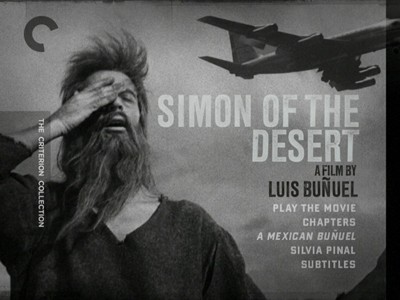
Luis Bunuel's 1965 short film Simon of the Desert may be one of the master surrealist's more straightforward efforts--or, at least, it should be straightforward enough to anyone raised with regular doses of Sunday School. The church I grew up in didn't believe in saints, but the temptations that Bunuel's Simon, whom he based on the story of Saint Simeon Stylites, will look familiar to anyone who has heard the tale of Jesus being tempted by Satan in the desert.
Simon (Claudio Brook) is a Christian ascetic who has been living atop a literal pedestal of religion for six years, six months, and six days. This life of denial and penitence, undertaken in the middle of a scorched desert, will prove his devotion to God and bring him closer to Heaven. Believers flock around him, other holy men revere him, and Simon shares the lessons he's learned with them all. As the film opens, a grateful patron is moving Simon from his simple pedestal to a fancier, taller tower that has been erected in his honor--an earthly reward for his persistent pursuit of divinity.
Perhaps it is the acceptance of this gift, or perhaps it's the auspicious and evil number inlaid in the duration of Simon's meditation, but the devil has now come to the desert to try to lure Simon down from his place of worship. The trickster appears as a woman (Silvia Pinal), first as a naughty schoolgirl and then in the guise of Jesus Himself. Satan also takes possession of a jealous priest to try to shake the people's belief in Simon through lies. These efforts fail, only giving the target more strength: Simon makes his vigil tougher, swearing to stand on only one leg.
For a notorious prankster who often had a laugh at the expense of organized faith, Bunuel portrays Simon's spiritual mission with the utmost respect. He still can't resist having a go at the false worshippers and dishonest holy men, however, showing how the gathered take advantage of Simon's miracles and how many priests are only coming to give tribute for the sake of appearances. In Bunuel's philosophy, the phony far outnumber the authentic.
And we do see that Simon is authentic because we see his temptations and his renunciation of the same. This doesn't just include the ones brought forth by Satan--though those are brought to life with showmanship and rather good special effects--but also the ones that creep into Simon's mind via normal trains of thought. Like Scorsese's portrait of Jesus in The Last Temptation of Christ, Simon sees himself in more normal surroundings, accepting love and family as his own, but he banishes such thoughts from his mind in affirmation of his faith.
There is only one thing that Simon cannot stand up against, and it is Satan's final gambit. Arguably, the sin of pride could also be Simon's downfall, with how zealously he challenges the devil to unload the full arsenal, but this is what the fallen one is relying on. In a Twilight Zone-worthy twist, the Devil transports Simon to a future city. Looking now like an existentially weary beatnik, Simon sits with the beautiful arc angel at a table in a rock 'n' roll club. When Simon finds nothing of interest in the bawdy decadence and demands to be returned home to his pedestal, Satan tells him that it is too late, that he has already been replaced--the implication being that he has not been replaced by another ascetic, but by modern life, by a society that rejects the oppressiveness of religion for the freedom of music and technology. Satan joins in the dance, laughing, leaving Simon alone in his 20th-century despair.
Ah, there's the rub! Here is where Bunuel lies in wait to needle the religious rank and file. In the closing sequence of Simon of the Desert, which spends a long time amongst the kids dancing before moving over to the bored looking Simon, thus letting us know how fun it is on the dancefloor, Bunuel is getting the last laugh, fulfilled for him in the bright and lovely smile of Silvia Pinal. "You may have been right," he seems to say to Simon, "but what good has it done you? The other side won anyway."
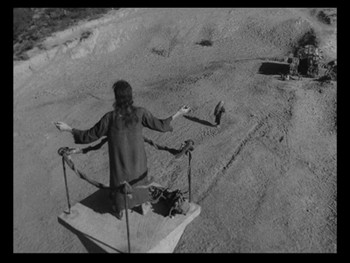
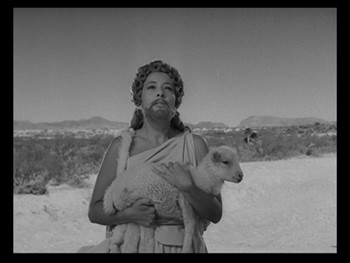
THE DVD
Video:
This Criterion edition of Simon of the Desert is presented in a full frame 1.33:1 aspect ratio, picture boxed so that on widescreen televisions there will be black bars on all four sides of the image. The picture quality is excellent, with good black-and-white values and solid resolution. There is some grain that is indicative of the age of the material, and the occasional section that might have a little damage, but hardly anything worth noting.
Though the main feature has been deinterlaced, the video extras have not been. You will likely see some blur and motion lines on some monitors when watching those.
Sound:
The original Spanish soundtrack is mixed in mono, and it sounds great. Very crisp, no hiss or metallic tones, everything quite clear. The English subtitles are well written and paced at a readable speed.
Extras:
Simon of the Desert - Criterion Collection is packaged in a clear plastic case with a double-sided cover. I like how the image on the DVD tray is of the Satanic Pinal as the school girl while the image on the disc is of the crone she turns into when Simon rejects her--one image conceals the other. The interior booklet is 28 pages long and filled with photos, chapter listings and credits, a 1970s interview with Luis Bunuel, and a new essay by critic Michael Wood, who has written extensively on Bunuel in the past.


The first of two extra features is a 1997 documentary entitled A Mexican Bunuel (56 minutes). It focuses on Bunuel's move to the States after the Spanish Civil War and his eventual return to directing in the 1940s via the film industry south of the border. Friends and colleagues are interviewed, and there are a ton of vintage photos, clips from the Mexican films, and even some interview footage of Bunuel. Amongst the notable commentators are Jeanne Bunuel, the director's wife, and Carlos Savage, who edited Simon of the Desert and many of the other 20 features Bunuel made in Mexico. We are also treated to a previously lost alternate ending for the 1950 feature Los olvidados, which Bunuel shot to satisfy the producer's desire for a happy finish but which was never used. Simon is also examined, as it was Bunuel's last Mexican film, and it fits snugly into a discussion of the filmmaker's strange relationship with the church. Fittingly, A Mexican Bunuel ends with efforts to remove Simon's 28-foot pedestal from the original shooting location, where it had rested for three decades, and move it to an alternate location where a Bunuel tribute was being put together. The plan achieves truly Bunuelian results.
Though Silvia Pinal is also in A Mexican Bunuel, the final extra is a new interview with the actress, filmed more than ten years later. Illustrated with clips from the movie, it runs 6 minutes, 40 seconds. She talks about working with Bunuel and how this film was originally intended to be one segment in an anthology movie.
The Pinal interview is in Spanish with English subtitles, and though all the interview subjects in A Mexican Bunuel speak in Spanish, the narration is actually in English
FINAL THOUGHTS:
Highly Recommended. Bunuel does more in 45 minutes of Simon of the Desert than most directors do with films that have a regular, twice-as-long feature-length running time. A parable, a satire, a Rod Serling-esque puzzler, this tale of a saintly ascetic trying to resist the temptations of a sexy devil honors the principled, skewers the inconsistent, and reminds us that being good may be honorable, but being bad looks a lot more attractive, as well as more durable.
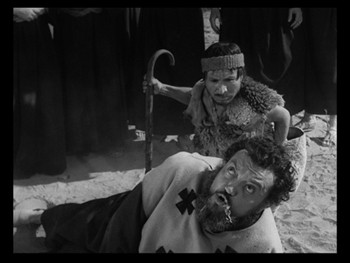
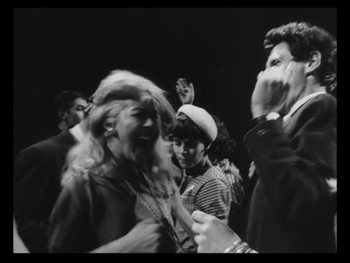
Jamie S. Rich is a novelist and comic book writer. He is best known for his collaborations with Joelle Jones, including the hardboiled crime comic book You Have Killed Me, the challenging romance 12 Reasons Why I Love Her, and the 2007 prose novel Have You Seen the Horizon Lately?, for which Jones did the cover. All three were published by Oni Press. His most recent projects include the futuristic romance A Boy and a Girl with Natalie Nourigat; Archer Coe and the Thousand Natural Shocks, a loopy crime tale drawn by Dan Christensen; and the horror miniseries Madame Frankenstein, a collaboration with Megan Levens. Follow Rich's blog at Confessions123.com.
|
| Popular Reviews |
| Sponsored Links |
|
|
| Sponsored Links |
|
|
| Release List | Reviews | Shop | Newsletter | Forum | DVD Giveaways | Blu-Ray | Advertise |
|
Copyright 2024 DVDTalk.com All Rights Reserved. Legal Info, Privacy Policy, Terms of Use,
Manage Preferences,
Your Privacy Choices | |||||||













